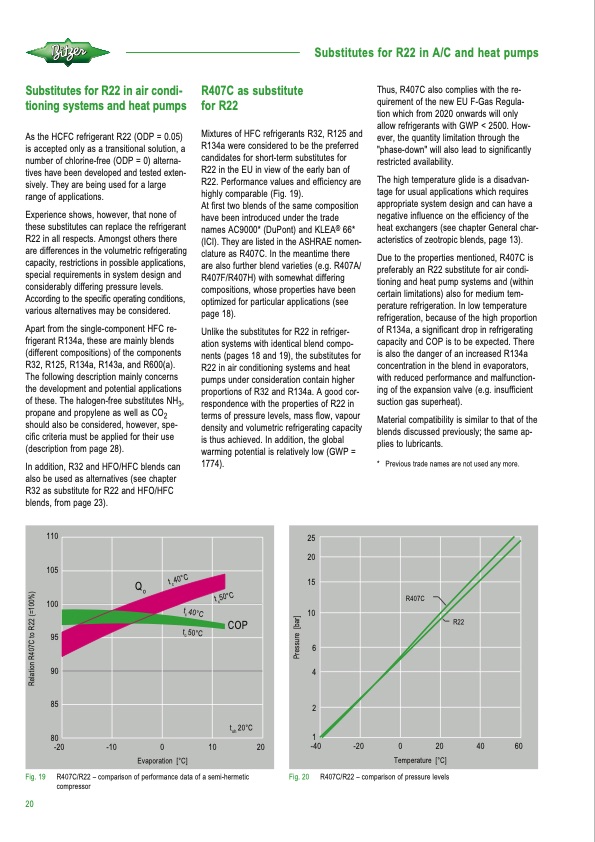
PDF Publication Title:
Text from PDF Page: 020
Substitutes for R22 in air condi- tioning systems and heat pumps As the HCFC refrigerant R22 (ODP = 0.05) is accepted only as a transitional solution, a number of chlorine-free (ODP = 0) alterna- tives have been developed and tested exten- sively. They are being used for a large range of applications. Experience shows, however, that none of these substitutes can replace the refrigerant R22 in all respects. Amongst others there are differences in the volumetric refrigerating capacity, restrictions in possible applications, special requirements in system design and considerably differing pressure levels. According to the specific operating conditions, various alternatives may be considered. Apart from the single-component HFC re- frigerant R134a, these are mainly blends (different compositions) of the components R32, R125, R134a, R143a, and R600(a). The following description mainly concerns the development and potential applications of these. The halogen-free substitutes NH3, propane and propylene as well as CO2 should also be considered, however, spe- cific criteria must be applied for their use (description from page 28). In addition, R32 and HFO/HFC blends can also be used as alternatives (see chapter R32 as substitute for R22 and HFO/HFC blends, from page 23). R407C as substitute for R22 Mixtures of HFC refrigerants R32, R125 and R134a were considered to be the preferred candidates for short-term substitutes for R22 in the EU in view of the early ban of R22. Performance values and efficiency are highly comparable (Fig. 19). At first two blends of the same composition have been introduced under the trade names AC9000* (DuPont) and KLEA® 66* (ICI). They are listed in the ASHRAE nomen- clature as R407C. In the meantime there are also further blend varieties (e.g. R407A/ R407F/R407H) with somewhat differing compositions, whose properties have been optimized for particular applications (see page 18). Unlike the substitutes for R22 in refriger- ation systems with identical blend compo- nents (pages 18 and 19), the substitutes for R22 in air conditioning systems and heat pumps under consideration contain higher proportions of R32 and R134a. A good cor- respondence with the properties of R22 in terms of pressure levels, mass flow, vapour density and volumetric refrigerating capacity is thus achieved. In addition, the global warming potential is relatively low (GWP = 1774). Thus, R407C also complies with the re- quirement of the new EU F-Gas Regula- tion which from 2020 onwards will only allow refrigerants with GWP < 2500. How- ever, the quantity limitation through the "phase-down" will also lead to significantly restricted availability. The high temperature glide is a disadvan- tage for usual applications which requires appropriate system design and can have a negative influence on the efficiency of the heat exchangers (see chapter General char- acteristics of zeotropic blends, page 13). Due to the properties mentioned, R407C is preferably an R22 substitute for air condi- tioning and heat pump systems and (within certain limitations) also for medium tem- perature refrigeration. In low temperature refrigeration, because of the high proportion of R134a, a significant drop in refrigerating capacity and COP is to be expected. There is also the danger of an increased R134a concentration in the blend in evaporators, with reduced performance and malfunction- ing of the expansion valve (e.g. insufficient suction gas superheat). Material compatibility is similar to that of the blends discussed previously; the same ap- plies to lubricants. * Previous trade names are not used any more. Substitutes for R22 in A/C and heat pumps ��� ��� ��� �� �� �� �� ��� ��� � �� �� ����������� ���� �� ��� ��� ���� �� �� �� �� � � � � ��� ��� � �� �� �� ����������� ���� ����� ��� Fig. 19 R407C/R22 – comparison of performance data of a semi-hermetic compressor 20 Fig. 20 R407C/R22 – comparison of pressure levels ������ � ����� �� ���� �� ���� �������� ����� �� ��� ������� �������� �����PDF Image | REFRIGERANT REPORT 21

PDF Search Title:
REFRIGERANT REPORT 21Original File Name Searched:
A-501-21_EN.pdfDIY PDF Search: Google It | Yahoo | Bing
CO2 Organic Rankine Cycle Experimenter Platform The supercritical CO2 phase change system is both a heat pump and organic rankine cycle which can be used for those purposes and as a supercritical extractor for advanced subcritical and supercritical extraction technology. Uses include producing nanoparticles, precious metal CO2 extraction, lithium battery recycling, and other applications... More Info
Heat Pumps CO2 ORC Heat Pump System Platform More Info
| CONTACT TEL: 608-238-6001 Email: greg@infinityturbine.com | RSS | AMP |